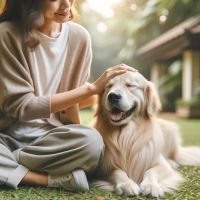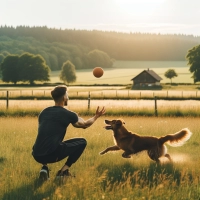Understanding How Touch Affects Dogs

This article explores the emotional and physiological effects of petting dogs. We'll delve into which spots dogs prefer to be petted, areas to avoid, and how this simple act influences both the canine and human participants. Discover the science behind the strokes and how to enhance the bonding experience through mindful petting.
Petting a dog the right way can lead to a deeper and more meaningful bond between pets and their owners. It reduces stress and anxiety, promotes a sense of well-being, and helps in understanding your pet’s needs and comfort levels. Both dogs and owners can experience heightened emotional connection and improved mental health.
Additional Insights on the Article Topic
Further exploration reveals that regular petting can help socialize dogs, making them more amenable to human interaction and less likely to exhibit aggressive behaviors in stressful situations.
- How can you tell if a dog enjoys being petted?
- What spots should be avoided to ensure the dog's comfort?
- What are the psychological and physical benefits for both dogs and their owners when engaging in regular petting?
- How can mindful petting improve the relationship between you and your pet?
Top Areas and Situations to Avoid When Petting a Dog
The Top of the Head:
- Many dogs find being patted on top of the head intimidating or uncomfortable because it requires them to look up, which can feel threatening.
The Muzzle or Nose:
- Petting a dog's muzzle or nose can be irritating for the dog, especially if done by someone unfamiliar. Dogs often perceive this as an invasion of personal space.
The Tail and Rear:
- The tail and rear end are sensitive areas. Many dogs dislike being touched near the base of the tail or around their hindquarters.
The Paws:
- Dogs are generally protective of their paws. Some may tolerate having their paws held by their owners, but this can be a no-go area for others, especially strangers.
The Underbelly:
- While some dogs enjoy belly rubs, approaching the underbelly too soon in a relationship can be seen as too bold or invasive.
During Eating:
- Interrupting a dog while it is eating by petting it can provoke anxiety or defensive aggression. It’s best to let them eat in peace.
While Sleeping or Resting:
- Dogs startled from sleep can react defensively. Always ensure a dog is fully awake before initiating any contact.
If the Dog Turns Away:
- If a dog turns away or moves to avoid contact, respect their choice and give them space. Forcing interaction can lead to stress or aggression.
When Showing Signs of Stress:
- If a dog is showing signs of stress (like yawning, licking lips, or lowering the head), it’s a clear indicator that they are not comfortable with interaction.
Sensitive Medical Areas:
- If a dog has injuries or sore spots, touching these areas can cause pain or discomfort, which might lead to an adverse reaction.
Additional Precautions:
- Avoid Hugging:
- Dogs do not naturally understand hugs. While some may tolerate it, others can perceive it as a threat or restriction of movement.
- Be Cautious with New Dogs:
- When meeting a dog for the first time, let the dog approach you first. Offer your hand to sniff, and watch the dog’s body language to gauge their comfort level before attempting to pet.
- Don’t Encourage Jumping Up:
- Petting a dog when it jumps up can inadvertently reinforce bad behavior. Encourage and reward calm approaches instead.
- Be Gentle with Small and Young Dogs:
- Small and young dogs can be especially sensitive to touch, so gentle strokes are necessary to avoid unintentional harm or fear.
- Watch for Ear Sensitivity:
- Some dogs might have sensitive ears due to medical issues like ear infections. Be observant and avoid this area if there are signs of discomfort.
Understanding these guidelines can help create a more respectful and enjoyable interaction for both dogs and humans. It’s about ensuring the dog’s comfort and trust, which in turn safeguards the person interacting with the dog.
Practical Example
Case Study: Max and Sarah
Sarah, a first-time dog owner, learned through observation and guidance that Max, her Golden Retriever, prefers being petted on his chest and under his chin rather than on the top of his head, which he finds intimidating. By adjusting how she approached Max, Sarah noticed an increase in positive interactions, with Max seeking out her touch more often, demonstrating the trust and comfort that developed from mindful petting.
- Approach your dog calmly to avoid startling them.
- Start petting in areas where dogs typically show comfort, like the side of the body.
- Observe your dog’s reactions closely.
- Avoid sensitive areas such as the tail, ears, and feet unless your dog is comfortable with it.
- Use a soft, soothing voice to enhance the calming effect.
- Vary the petting speed and pressure according to your dog’s preference.
- Regularly incorporate petting into your routine to maintain a connection.
- Never force petting if your dog seems uncomfortable or distressed.
- Encourage family members to pet correctly using the same techniques.
- Use petting as a reward during training to reinforce positive behaviors.
- Dogs can sense kindness through human touch, which can significantly lower their heart rate, indicating a state of relaxation and trust.
Conclusion
Mindful petting is more than just a way to pamper your pet; it's a critical component of building a lasting and loving relationship. By understanding the best practices for petting your dog, you can ensure that each touch strengthens the bond, supports their emotional health, and enriches your shared life.
"The Other End of the Leash" by Patricia B. McConnell
- This book offers a fascinating perspective on the relationship between humans and dogs from a professional animal behaviorist. It explores how human behavior can affect dogs and provides practical advice to improve the way we interact with our pets.
"Inside of a Dog: What Dogs See, Smell, and Know" by Alexandra Horowitz
- In this book, the author delves into the world from a dog’s point of view, providing insights into how dogs perceive their surroundings. It’s a great resource for understanding how dogs might experience the act of being petted and their environment in general.
"How Dogs Love Us: A Neuroscientist and His Adopted Dog Decode the Canine Brain" by Gregory Berns
- This book explores the capacity of dogs for emotions and elucidates the deep bond between humans and dogs. It includes findings from the author's work using MRI technology to study the canine brain.
"Dog Sense: How the New Science of Dog Behavior Can Make You A Better Friend to Your Pet" by John Bradshaw
- John Bradshaw uses the latest scientific research to show how humans can live in harmony with—not just dominion over—their dogs. It discusses how traditional methods of training might not always be the best approach and offers newer, more scientifically grounded ways.
"Decoding Your Dog: Explaining Common Dog Behaviors and How to Prevent or Change Unwanted Ones" by American College of Veterinary Behaviorists
- This book is a comprehensive guide to understanding dog behavior and includes contributions from many experts. It provides evidence-based, practical advice for addressing a variety of behaviors, including stress and anxiety, which may be relevant for a dog being petted.
"Canine Confidential: Why Dogs Do What They Do" by Marc Bekoff
- Marc Bekoff explores the moral lives of dogs, their emotions, and how they communicate. This book can help dog owners better interpret their pet’s reactions during interactions like petting.
- Video response to the topic: Understanding How Touch Affects Dogs
While self-care strategies are valuable for managing symptoms related to psychological issues, they are not a substitute for professional treatment. It's important to recognize that self-care complements but does not replace the expert guidance and personalized therapy provided by qualified mental health professionals. Engaging in self-care is beneficial for general well-being and can be part of a broader treatment plan, but it's crucial to consult with a healthcare provider to ensure that you are receiving comprehensive care, especially for complex psychological conditions. This approach ensures that any underlying issues are properly addressed, potentially enhancing the effectiveness of self-care practices.







